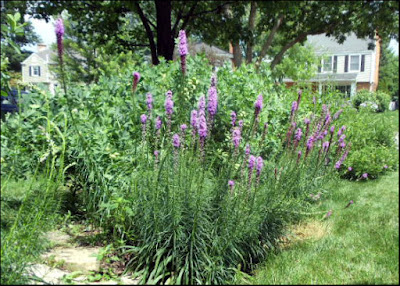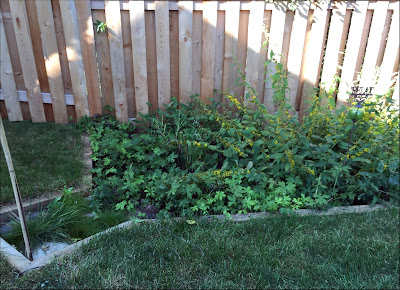University of Illinois PhD students Pongsakorn “Tum” Suppakittpaisarn, pictured above on the right, and Fatemeh Saeidi-Rizi, pictured above on the left, study rain gardens—but not in the way you’d expect. Instead of measuring infiltration rates and pollution reduction capacity, Tum and Fatemeh want to know what happens in our brains and bodies when we see this green infrastructure practice.
A growing number of studies draw connections between access to green spaces and our physical and mental health. But, Tum said, most of that work has revolved around larger, more ubiquitous landscapes like public parks and tree-lined streets.
“We know green spaces generally are good for mental health,” he said. “But the ‘how’ and ‘why’ is still unclear, especially with rarer landscape types like rain gardens.”
So Tum and Fatemeh, along with collaborators at the University of Illinois’ Sustainability and Human Health Lab and the Health People-Health Landscape Lab at National Taiwan University, are working together to measure physical responses and changes in brain activity triggered by images of rain gardens.
The team has compiled 216 rain garden photos taken across the U.S. into nine different videos. In Illinois, Tum will use biofeedback sensors to measure what happens to participant heart rates, body temperatures, and more when they see these videos.

At the same time, Dr. Chun-Yen Chang’s team in Taiwan will use functional magnetic resonance imaging—better known as fMRI—to monitor and map changes in brain blood flow when participants are shown rain garden photos after being put through a series of tests designed to cause mental fatigue.
The researchers only began testing participants this spring, but they have a few predictions about the final results.
“It’s possible that seeing rain gardens in an urban space will help people recover from mental fatigue faster,” said Tum. “On the other hand, rain gardens with a lot of messy plants may make people feel uncomfortable, which may lead to them feeling more stress or mentally fatigue.”
It is not uncommon for more than one home on a block to have excess water due to stormwater runoff. The good thing about a rain garden is that they can adapt to suit the need of the homeowner. They can be placed wherever on the property they are needed.
Originally Dan and Libby Reimann’s Mount Prospect, Ill. home did not have any problems with standing water. It was not until the couple had an addition built onto their house did they encounter problems. During the construction, their sump pump began to run continuously, flooding their front yard and a portion of the neighbor’s driveway. When the couple contacted local authorities, they were given two suggestions, the Reimanns could tap into the sewer system or they could build a rain garden.
The couple didn’t want to tap into the sewer system if they could avoid it and the village encouraged the idea of a rain garden. With some deliberation as well as online searching and learning more about rain gardens, Dan and Libby decided they would try to build one.
In Dan’s research he came across Kevin Herbert, a landscaper in the northwest suburbs of Chicago. They contacted Herbert to design and construct their garden. Not knowing exactly what they wanted or what to put in the garden, they gave Herbert free reign. From the shape of the garden to the flowers in the garden, Herbert did it all.
 Not only did Herbert take charge of the whole design process but he also helped in the garden’s maintenance. The couple hired him to take care of the garden following its first year of installment. In that year he taught them what to weed, when to cut down plants and provided the couple with pictures of what each plant should look like when fully grown as a way to tell them apart. He left them the initial sketch of the design of the garden with what flowers go where.
Not only did Herbert take charge of the whole design process but he also helped in the garden’s maintenance. The couple hired him to take care of the garden following its first year of installment. In that year he taught them what to weed, when to cut down plants and provided the couple with pictures of what each plant should look like when fully grown as a way to tell them apart. He left them the initial sketch of the design of the garden with what flowers go where.
The Reimann garden is full of blooming flowers. They were particularly happy with the selection because they were picked to ensure that flowers are always in bloom, spring through fall. In the spring, the garden is adorned by blue and pink from the blue flags, blazing star and prairie smoke. When summer begins, the Reimanns can start to see white, purple and yellow from the meadowsweet, Monarda and black-eyed Susans. Black-eyed Susans are joined by white turtlehead and New England asters bloom in the late summer to early fall. The garden keeps these colors until the frost.
Dan’s advice to homeowners who know little to nothing about rain gardens, is to not let fear stop them. “They should just go for it,” Dan said. “And don’t be afraid to ask for help.”
When their neighbor Amy Hempleman saw how well the garden was working she took his advice, even taking their suggestion of having Herbert help create their garden in the spring of 2014.
 The Hempleman garden was different in one major way—the location. While water was spilling into the front of the Reimann’s yard, Hempleman had to solve a problem in the backyard. The back corner just behind the garage began to flood from excess water coming from the gutters. Hebert used this as well as the natural slope of the yard to his advantage when he designed this garden. The water is routed along the sidewalk downspout and into the garden.
The Hempleman garden was different in one major way—the location. While water was spilling into the front of the Reimann’s yard, Hempleman had to solve a problem in the backyard. The back corner just behind the garage began to flood from excess water coming from the gutters. Hebert used this as well as the natural slope of the yard to his advantage when he designed this garden. The water is routed along the sidewalk downspout and into the garden.
Hempleman is very happy with the garden, describing it as attractive and bright in the summer. When in full bloom, the garden has bluejackets, broad leaf goldenrod, nodding onion as well as ivory sedge and plantain leaved sedge. The balance between flowers and grass-like plants creates a full garden that does its job as well as adding to Hempleman’s yard.
Not only was Hempleman happy with the garden’s appearance, but she also feels good about the way it took care of the water problem. This experience has given Hempleman a new interest in plants, to be more specific, with native plants. As she has seen the beauty and functionality of them firsthand, she has started to notice and look for them. She expressed a wish for clearer labels of plants, to make it easier for gardeners that want to find native plants. This would also educate people who may not know the native plants of their area and could pique their interest.
Hempleman looks forward to watching her garden grow in the upcoming years.
-Victoria Figueroa
One of the best online resources for sustainable landscape and lawn care in Illinois is now available in Spanish. Like its sister site Lawn Talk, Hablemos Del Cesdped includes tips and resources for planting and maintenance, including common lawn care mistakes to avoid.
With help from these sites, homeowners and landscape professionals in northern Illinois can cultivate healthy lawns while still conserving water and preventing harmful chemicals from washing into nearby lakes and rivers. Specific natural lawn care tips include testing soil and adjusting nutrient levels as needed at the start of the season, choosing the right grass for the site, and letting lawns go dormant during dry months. The sites also provide information on lawn cultivation equipment and choosing lawn care services.
Greg Hitzroth, IISG’s organisms in trade outreach specialist, recently attended both the Northern Midwest Zen Nippon Airinkai Koi Club Show and the Indiana Koi and Water Garden Club Show to speak directly with water gardeners about making the right choices to prevent selecting and spreading invasive species.
The overall message he shared with the attendees was that even common plants associated with water gardens can quickly become “aquatic invaders” under the right conditions. Aquatic invaders are plants and animals that cause ecologic and economic harm once established in public waterways, and removing them can be very expensive and often impossible. One way that aquatic invaders are introduced or spread into public waters is through the intentional or unintentional release of species from water gardens and koi ponds.
Prevention is the best and most cost-effective way to keep aquatic invaders from spreading, and the gardeners and landscapers heard about a number of methods at the shows.
The first way to keep these species from spreading is to avoid buying and using them at all. Instead, Greg recommended purchasing native species and avoiding known invasives like those on identified by Reuben Keller of Loyola University Chicago and Christa Gants and David Lodge of University or Notre Dame in their article (PDF). The Chicago Botanic Garden’s website has a list of invasive species and alternatives that are not invasive or environmentally threatening to help guide gardeners’ purchase.
Additionally, simple steps like finding appropriate alternatives to releasing these species (including trading, returning them to retailers, or properly disposing of them) can have a profound effect in keeping aquatic invaders from establishing in other areas.
Greg will be presenting this information at other upcoming shows and events, including this weekend’s Midwest Koi and Pond Show, and looks forward to providing information about preventing aquatic invaders to gardeners and hobbyists throughout the season. Illinois-Indiana Sea Grant is creating a number of educational materials about preventing these species from spreading, and more information about those will be posted soon.



